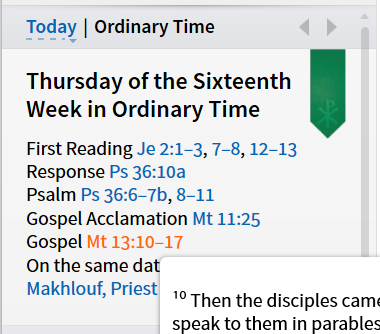Today’s guest post is by Steve Ray, popular speaker and author of St. John’s Gospel, Upon This Rock, Crossing the Tiber, and host of the popular TV series, The Footprints of God.
When Verbum asked me what books I would recommend for summer reading, it was easy to come up with some great titles.
I use Verbum every day, and there are certain books I use over and over again. The books are all interconnected, so while you could sit and read any of the books I picked (they’re all that good!), I use them more like reference works.
 For example, from the Verbum homepage, I like to start every day by simply clicking on today’s Gospel. Verbum springs into action. It opens an entire screen of windows—like having dozens of books all open to the exact right page. I have the Great Commentary of Cornelius à Lapide prioritized as a favorite, so it shows up automatically, and I can easily use parallel resources to switch to the Catholic Commentary on Holy Scripture, and the Ancient Christian Commentary on Scripture. With just these three commentaries, I’ve uncovered spectacular insights about the Gospel (and Verbum has plenty more).
For example, from the Verbum homepage, I like to start every day by simply clicking on today’s Gospel. Verbum springs into action. It opens an entire screen of windows—like having dozens of books all open to the exact right page. I have the Great Commentary of Cornelius à Lapide prioritized as a favorite, so it shows up automatically, and I can easily use parallel resources to switch to the Catholic Commentary on Holy Scripture, and the Ancient Christian Commentary on Scripture. With just these three commentaries, I’ve uncovered spectacular insights about the Gospel (and Verbum has plenty more).
At any point in this process, I can run a Verbum Topic Guide or Passage Guide, and I’m presented with default collections of links to the Catechism, Church Documents, and the writings of the Church Fathers. The last category is often primarily populated by the Early Church Fathers Collection available in most of the Verbum Libraries. However, I’ve found the addition of the CUA Fathers of the Church Series invaluable in my study of any passage. I couldn’t even capture all the results I got just from today’s Gospel reading! Such easy access to our rich Tradition!

 Finally, the Anchor Yale Bible Dictionary is my go-to source for definitions. See more on why Bible dictionaries are awesome in this video. The Anchor Yale Dictionary has extensive definitions for over 6,000 entries. And it gets pulled right into the Bible Facts frame and opens on a double click of almost any word. With definitions this extensive, even clicking on words I already understand yields new discoveries.
Finally, the Anchor Yale Bible Dictionary is my go-to source for definitions. See more on why Bible dictionaries are awesome in this video. The Anchor Yale Dictionary has extensive definitions for over 6,000 entries. And it gets pulled right into the Bible Facts frame and opens on a double click of almost any word. With definitions this extensive, even clicking on words I already understand yields new discoveries.
The rest of my recommendations are just great titles that everyone should read or be familiar with.
For a marvelous Catholic Bible Study program that anyone can start in their parish or community, I’ve always recommended Catholic Scripture Study International. It is the best program you will find anywhere!! And it’s even better in Verbum. All the Bible links are connected directly to Scripture and the verse memorization works right in the software.
I used Verbum to write all my books, including Crossing the Tiber, Upon This Rock, and St. John’s Gospel. They take on a whole new dimension within the Verbum software.
See my complete list of recommendations here.
Addendum (by Alex Renn):
Steve asked me to address a question from a user on his blog: “What does your entire screen look like after you click on the daily reading?” Here’s the basic answer plus some additional considerations:
Steve’s layout will look something like this:

1) The Lectionary layout does not actually change as far as panels are concerned. Setting priorities will change what appears in each panel. This post, though old, is a great tutorial on setting priorities. You will be able to customize the order of the Bibles that appear in the top middle pane, and the commentary that populates the bottom middle. This is where he mentioned the Great Commentary of Cornelius à Lapide appearing in his post above.
2) It looks like some of the screenshot panels were pulled out of context to reveal more information (that may be why they look different from what you’re seeing.)
3) The topic guide was accessed by right clicking the Gospel in the Lectionary, making sure “Bible” is selected on the right, and Clicking “Passage Guide” on the left. Scroll down to see the Church Fathers section (pictured above).

4) Lastly, the dictionary was also prioritized as shown in number 1, so that double-clicking will open the Anchor Yale Bible Dictionary if possible. If you double click a word that isn’t an entry, it will open a different dictionary instead.
Hope that helps!







[…] Another screen shot is here. […]
Thanks for both of your comments. I would think a class like that at Franciscan would have been a no-brainer! I hope we get a Catholic class to hit the road like the Morris Proctor classes.
Oh and BTW…I checked out the complete list and had all but two, which I ordered. Thank you for posting your valuable recommendations.
I too use Verbum every day, for lectionary study and my reading plans (currently CCC in a year and NJB OT in a year). I saved custom layouts that show the main text in the left side and the commentaries/links-go-here in the right pane. I can read and study related resources in one view this way. I update the active layout at the conclusion of today’s reading/study so it’s cued up for the next day. I right-arrow through parallel resources (all the commentaries) so it’s like referring to a whole bookshelf of other books easily, without having to dig through a whole physical bookshelf full of books (because really, who has time to do that)! Over time, I’ve accumulated lots of resources, older and recent ones, and some are more academic and some are more devotional. I feel like this is the easy way to become an amateur Bible scholar! My knowledge of Scripture and our holy faith has deepened and broadened, and preparing for Mass this way makes my engagement in the readings at Mass so rich. I would love to see more Catholics digging deep into the Bible, the Catechism, and the lectionary this way. It would be great to have a preconference workshop at FUS Journey Through Scripture/Applied Biblical Studies to teach people how to use Verbum effectively–like Camp Logos 1-2 but geared towards Verbum and the Catholic collections and resources and methods. I suggested this but it was shot down because they’re more about content than tools. Pity.